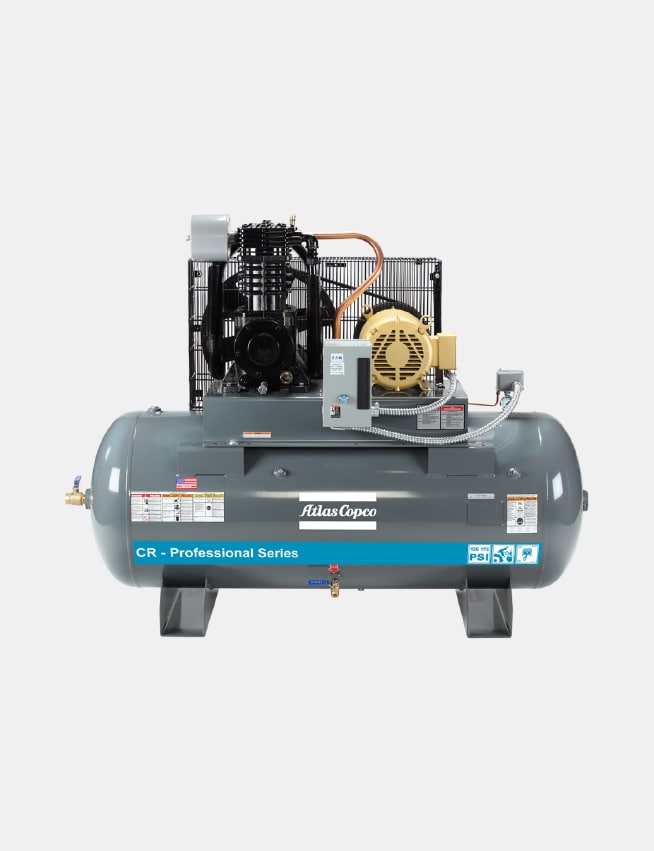When you’re considering purchase an air compressor, it’s important to know how to select the right size for your needs. An industrial air compressor which is too large may require a larger investment than you’re comfortable with, while one that is too small may exceed its duty cycle while trying to keep up with your rate of use.
However, there are several factors you’ll need to to consider when you’re selecting the right air compressor for your pneumatic tool selection so that you can maintain an appropriate flow of cubic feet per minute, air pressure in terms of pounds of pressure per square inch, and similar concerns. Do you need a larger tank, a portable air compressor for construction or mobile use, rotary screw compressors designed to run continuously?
In this article, we’ll look over all of the basic differences in air compressors, air tool types, tank size, and other factors that may impact your selection when choosing an air compressor for industrial applications. Whether you need something portable with a smaller compressor tank to run an impact wrench on your tow truck or something with a storage tank that can handle the compressed air volume demanded by larger tools, you’ll be able to make a smarter decision after reading this guide.
CFM vs. PSI
Let’s start with some basic measurements that are used with a gas or electric air compressor. The CFM rating has to do with how much air the air compressor is able to move over the course of a minute in terms of cubic feet of air at a particular pressure. This has to do with high-demand air tools that have a higher CFM requirement to ensure that they work properly, such as a paint sprayer or sandblaster.
By comparison, PSI refers to pounds per square inch, a measurement of pressure that is needed. Though high CFM tools may require more airflow, other tools may require a higher pressure to get the job done, such as a finish nailer set to 90 PSI to drive a nail into a hard piece of trim on construction sites. Because it only uses the air intermittently instead of continuously, it’s okay if it has a smaller tank, provided that it can reach the higher pressure needed for the air-powered tool to get the job done.
These factors can impact how your air compressor will work with your pneumatic tools. Smaller models with an electric motor may work well for most home garage or tire inflator needs, but mobile units or larger horsepower motors may require a different power supply to operate effectively, which can also impact your overall performance and installation process. For this reason, it’s important to consider not only the tank size when considering the size compressor that you need, but also the purpose you’ll put your electric compressor to in the course of operation.
Types of Air Tools
Let’s start by looking at the types of tools that are used and whether they are considered high-demand or low-demand air tools. High demand tools tend to vent the air to the atmosphere while in operations, such as a paint sprayer, sandblaster, powder coater, or texture gun. This is because the air that is released from a larger compressor with a higher tank capacity pushes the material out as it exits the air tool on a continuous basis, causing it to be used up in a higher number of cubic feet per minute.
Low-demand air tools, by comparison, may use a bit of air at a time, but it’s not as continuous. In these cases, such as a brad nailer, roofing nailer, or similar air tool, the air is only expressed a little at a time, because the air is used to drive one nail at a time, limiting how much air is exiting the system from a pancake compressor or other small compressor that is capable of reaching a higher pressure.
These different levels of demand create specific requirements when selecting an air tool. For painting or other high-demand use, you may require a stationary compressor or a rotary screw compressor that can provide a constant, large volume of air for your tools. By comparison, low-demand air tools may require a higher PSI, making a dual-stage compressor a better option because it can build a higher pressure while using a tank that has smaller physical dimensions.
Tank Size
Tank size is typically measured in terms of gallons, with seven gallons equaling a cubic foot. However, it’s important to understand that a seven-gallon tank is capable of delivering much more than one cubic foot of air per minute at sea level pressure. Because the air is compressed, your tank will hold much more air than you may expect, because it is at a higher pressure.
Generally speaking, you’ll want to make sure that the air compressor that you’re considering can deliver both the PSI and the CFM that you need for your tools to work effectively. As an example, a pancake compressor may be capable of delivering the CFM that you need but may exceed its duty cycle due to the small physical dimensions of the tank causing it to constantly run to refill it. If in doubt, always go up in tank size to allow for future growth.
Selecting the Right Size Air Compressor
Most air tools will have a specific minimum requirement for PSI, with high-demand air tools also having a specific CFM requirement. Trying to operate air tools without sufficient pressure or air flow will be very frustrating and can cause early failure of the air compressor due to cycling beyond its rated duty cycle. This type of operation can cause your air compressor to fail prematurely, costing your company a lot of money to replace it when you could have been using a slightly more expensive, larger capacity air compressor for many more years into the future.
To calculate the minimum CFM and PSI needed, determine the total needs of the tools you’ll expect use simultaneously on that system. For stations where your employees switch between tools, calculate based on the highest-use tools for each station. Add these together to determine the minimum CFM and PSI for your air compressor, then add a buffer for flexibility in the future. Don’t worry about changing out your air compressor every time that you upgrade your tool sets or add to your company’s operation!
Similarly, you’ll need to determine your tank size based on CFM needs with a buffer for low-demand tools in use at the same time. If in doubt, go with a larger tank size to meet your company’s needs without having to change your compressor in the future. In some cases, an air compressor with a three-phase power source or a rotary screw compressor may be needed to keep up with high-demand systems, making it easier for you to expand your business quickly without the added expense of a new air compressor.
If your company will be upgrading your existing tools, it’s important to include those tools in your calculations so that you don’t have to replace your air compressor as soon as you’ve added new tools to your system. No matter what type of air compressor you select, making sure that it provides at least some additional capability allows you to get more use out of your system long into the future, despite slight shifts in demand and changing needs in your business.
Shop Advanced Air & Vacuum for all your Air Compressor needs!
By selecting the proper air compressor for your company’s business, you’ll be able to not only meet, but also expand your business in the future without the expense and trouble of upgrading your air compressor at the same time. Selling air compressors of all sizes, CFM airflow and PSI pressures, Advanced Air & Vacuum has exactly what you need to keep your operation running effectively, including:
- Large Storage Tank Capacity: Available in single and three phase power sources, the Advanced 10 HP Horizontal Air Compressor has a huge 120-gallon tank capacity.
- Dual-Stage Compressors: The Quincy QT-54 allows you to reach higher pressures with dual-stage compression, while taking up less shop space with a vertical layout.
- Rotary Screw Compressors: In addition to simpler configurations, our selection of Atlas air compressors exceed 30 HP, providing plenty of air flow for high-demand tools.
- Portable Air Compressors: For the home garage, the Quincy Q12120P provides the perfect combination of professional performance and easy portability.
We also provide a range of industrial air compressor rentals, which includes oil free rental air compressor options. If you’re wanting to try a system out before you make your purchase, we offer vacuum pump and hose rentals, too. If you’re not sure what you’re looking for, we’re happy to help you find the perfect air compressor for your needs, all with a simple phone call. Please feel free to contact us today with any questions, for more information, or to get a quote on your next compressed air system.

